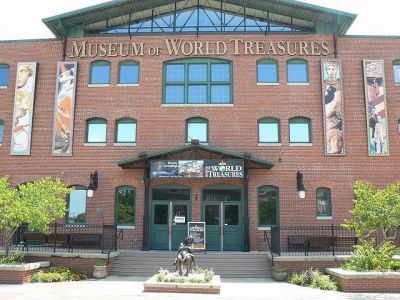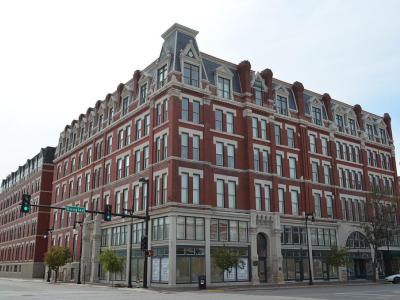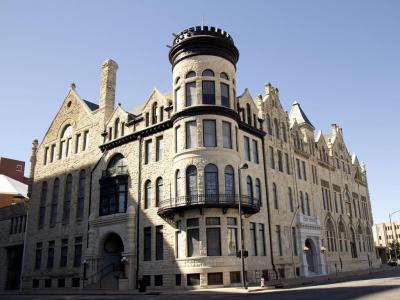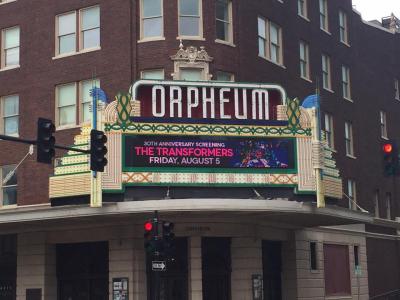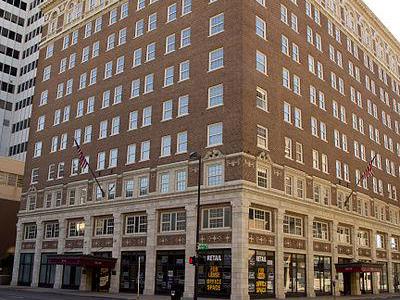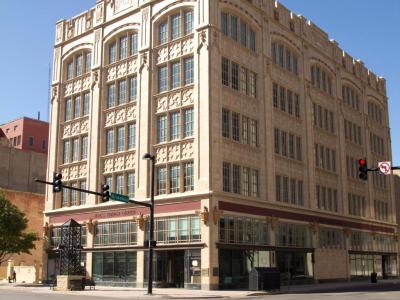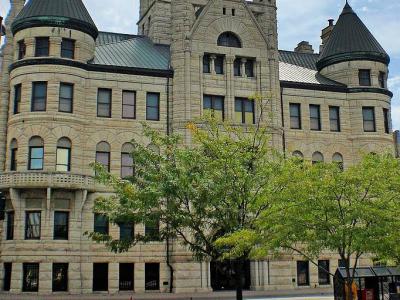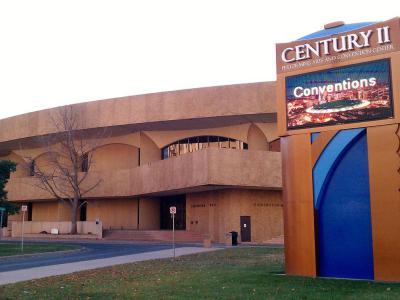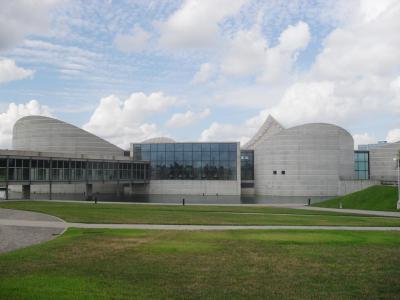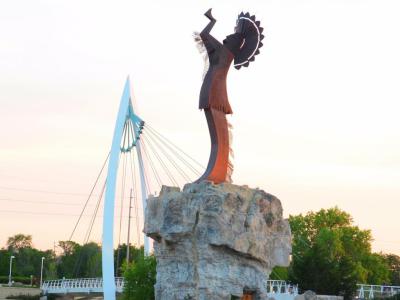Wichita Introduction Walking Tour (Self Guided), Wichita
In the heart of America, Wichita, Kansas, is often hailed as "The Air Capital of the World” for its important role in the airplane manufacturing industry.
Originally a humble trading post in the 1860s, it has evolved into a bustling metropolitan hub, spurred by the arrival of the railroad and the subsequent cattle drives. This pivotal era marked Wichita as a significant center for the cattle trade, earning it the nickname "Cowtown." The legendary lawman in the American West, Wyatt Earp, served there as a police officer for nearly a year.
Nestled at the confluence of the Arkansas and Little Arkansas Rivers, Wichita’s name is derived from the Wichita Native American tribe who lived in the territory and were driven from their land by Confederate forces during the American Civil War.
Wichita’s rapid growth in the early 20th century was fueled by the burgeoning aircraft industry, shaping its global economic standing. The city's prominence in aviation expanded further when its facilities became part of Boeing. In the late 1990s and 2000s, the municipal government and local organizations began collaborating to redevelop downtown Wichita and older neighborhoods.
Among the architectural and cultural gems that narrate the city's story is Old Town Square, a vibrant district that showcases Wichita's revitalization of its historic warehouse area into a dynamic mix of restaurants, shops, and entertainment venues. Nearby, the Museum of World Treasures offers a fascinating glimpse into global history with artifacts ranging from dinosaur fossils to Egyptian mummies.
Further weaving the city’s – architectural – story are the Lassen Hotel, Kress Building, and the Wichita-Sedgwick County Historical Museum, each adding their own historical and aesthetic value. The Century II Performing Arts & Convention Center, a modernist icon since the 1960s, remains at the forefront of the city’s cultural scene, hosting numerous events and performances.
A visit to Wichita would be incomplete without experiencing the Exploration Place, a science museum that captivates minds with interactive exhibits and innovative displays. Lastly, the majestic Keeper of the Plains Sculpture offers a symbolic connection to Wichita's native roots and a spectacular sight, especially during its nightly Ring of Fire ceremony.
Wichita provides an enriching backdrop to discover and enjoy, beckoning visitors to delve into its rich heritage, explore its myriad attractions, and partake in its vibrant community life. So, join us on the self-guided tour of this dynamic city and create for yourself a truly unforgettable experience!
Originally a humble trading post in the 1860s, it has evolved into a bustling metropolitan hub, spurred by the arrival of the railroad and the subsequent cattle drives. This pivotal era marked Wichita as a significant center for the cattle trade, earning it the nickname "Cowtown." The legendary lawman in the American West, Wyatt Earp, served there as a police officer for nearly a year.
Nestled at the confluence of the Arkansas and Little Arkansas Rivers, Wichita’s name is derived from the Wichita Native American tribe who lived in the territory and were driven from their land by Confederate forces during the American Civil War.
Wichita’s rapid growth in the early 20th century was fueled by the burgeoning aircraft industry, shaping its global economic standing. The city's prominence in aviation expanded further when its facilities became part of Boeing. In the late 1990s and 2000s, the municipal government and local organizations began collaborating to redevelop downtown Wichita and older neighborhoods.
Among the architectural and cultural gems that narrate the city's story is Old Town Square, a vibrant district that showcases Wichita's revitalization of its historic warehouse area into a dynamic mix of restaurants, shops, and entertainment venues. Nearby, the Museum of World Treasures offers a fascinating glimpse into global history with artifacts ranging from dinosaur fossils to Egyptian mummies.
Further weaving the city’s – architectural – story are the Lassen Hotel, Kress Building, and the Wichita-Sedgwick County Historical Museum, each adding their own historical and aesthetic value. The Century II Performing Arts & Convention Center, a modernist icon since the 1960s, remains at the forefront of the city’s cultural scene, hosting numerous events and performances.
A visit to Wichita would be incomplete without experiencing the Exploration Place, a science museum that captivates minds with interactive exhibits and innovative displays. Lastly, the majestic Keeper of the Plains Sculpture offers a symbolic connection to Wichita's native roots and a spectacular sight, especially during its nightly Ring of Fire ceremony.
Wichita provides an enriching backdrop to discover and enjoy, beckoning visitors to delve into its rich heritage, explore its myriad attractions, and partake in its vibrant community life. So, join us on the self-guided tour of this dynamic city and create for yourself a truly unforgettable experience!
How it works: Download the app "GPSmyCity: Walks in 1K+ Cities" from Apple App Store or Google Play Store to your mobile phone or tablet. The app turns your mobile device into a personal tour guide and its built-in GPS navigation functions guide you from one tour stop to next. The app works offline, so no data plan is needed when traveling abroad.
Wichita Introduction Walking Tour Map
Guide Name: Wichita Introduction Walking Tour
Guide Location: USA » Wichita (See other walking tours in Wichita)
Guide Type: Self-guided Walking Tour (Sightseeing)
# of Attractions: 11
Tour Duration: 2 Hour(s)
Travel Distance: 3.9 Km or 2.4 Miles
Author: Dee
Sight(s) Featured in This Guide:
Guide Location: USA » Wichita (See other walking tours in Wichita)
Guide Type: Self-guided Walking Tour (Sightseeing)
# of Attractions: 11
Tour Duration: 2 Hour(s)
Travel Distance: 3.9 Km or 2.4 Miles
Author: Dee
Sight(s) Featured in This Guide:
- Old Town Square
- Museum of World Treasures
- Carey House
- Scottish Rite Temple
- Orpheum Theater
- Lassen Hotel
- Kress Building
- Wichita-Sedgwick County Historical Museum
- Century II Performing Arts & Convention Center
- Exploration Place
- Keeper of the Plains Sculpture
1) Old Town Square
Nestled in the heart of Wichita, Old Town Square is a bustling hub of activity and charm, attracting both locals and visitors with its vibrant atmosphere. This area is home to over 100 businesses, making it a sought-after destination for its diverse array of restaurants, shops, clubs, theaters, galleries, museums, and stores. In addition to its commercial appeal, Old Town has become a popular residential area, featuring hundreds of newly renovated apartments, luxury condos, and two of Wichita's finest hotels. The blend of residential and commercial spaces contributes to Old Town's dynamic and thriving community.
The character of Old Town is defined by its distinctive architectural features, with brick-lined streets, historic lampposts, and a collection of converted brick warehouses that date back to the mid-1800s. These buildings, constructed with brick and native limestone accents, add a historical and aesthetic appeal to the area. This unique blend of old and new creates a picturesque setting that attracts both visitors and new residents.
Old Town Square itself is a central point of relaxation and enjoyment within the downtown area. Surrounded by local retailers and restaurants, the square offers green spaces, benches, lighting, and fountains, making it an ideal spot for people to unwind and enjoy the scenery. In the summer, the splash fountains are a hit with families, providing a fun and refreshing way to cool off.
The character of Old Town is defined by its distinctive architectural features, with brick-lined streets, historic lampposts, and a collection of converted brick warehouses that date back to the mid-1800s. These buildings, constructed with brick and native limestone accents, add a historical and aesthetic appeal to the area. This unique blend of old and new creates a picturesque setting that attracts both visitors and new residents.
Old Town Square itself is a central point of relaxation and enjoyment within the downtown area. Surrounded by local retailers and restaurants, the square offers green spaces, benches, lighting, and fountains, making it an ideal spot for people to unwind and enjoy the scenery. In the summer, the splash fountains are a hit with families, providing a fun and refreshing way to cool off.
2) Museum of World Treasures (must see)
The Museum of World Treasures is a fascinating destination that offers a comprehensive journey through world history. It boasts an incredibly diverse collection, with exhibits ranging from prehistoric fossils to modern historical artifacts. Visitors can marvel at impressive specimens such as Tyrannosaurus, Daspletosaurus, and Tylosaurus, as well as Egyptian mummies that offer a glimpse into ancient civilizations. The museum also houses unique artifacts like the signatures of all American presidents, a section of the Berlin Wall, and the Scarecrow's pitchfork from the classic film "The Wizard of Oz."
The museum's layout is thoughtfully organized across three floors, each dedicated to different historical themes. The first floor is a haven for paleontology enthusiasts and those interested in ancient human history, featuring a rich array of fossils and a dedicated geology room. This floor provides a foundational understanding of the earth's history and the evolution of life on our planet.
Ascending to the second floor, visitors encounter exhibits focused on military history, world leaders, and royalty. This section highlights significant events and figures that have shaped global history, offering insights into the political and military forces that have influenced the world. The collection here includes detailed displays on various wars, presidential memorabilia, and artifacts related to royal families from different cultures.
The third floor is dedicated to American history, featuring a diverse ensemble of materials that capture the essence of the nation's past. From significant historical events to cultural artifacts, this floor provides a well-rounded view of America's heritage. Additionally, the top floor includes a spacious banquet room, which can be rented for private events, making the museum not only a place of learning and exploration but also a unique venue for special occasions.
The museum's layout is thoughtfully organized across three floors, each dedicated to different historical themes. The first floor is a haven for paleontology enthusiasts and those interested in ancient human history, featuring a rich array of fossils and a dedicated geology room. This floor provides a foundational understanding of the earth's history and the evolution of life on our planet.
Ascending to the second floor, visitors encounter exhibits focused on military history, world leaders, and royalty. This section highlights significant events and figures that have shaped global history, offering insights into the political and military forces that have influenced the world. The collection here includes detailed displays on various wars, presidential memorabilia, and artifacts related to royal families from different cultures.
The third floor is dedicated to American history, featuring a diverse ensemble of materials that capture the essence of the nation's past. From significant historical events to cultural artifacts, this floor provides a well-rounded view of America's heritage. Additionally, the top floor includes a spacious banquet room, which can be rented for private events, making the museum not only a place of learning and exploration but also a unique venue for special occasions.
3) Carey House
Constructed between 1886 and 1887, the Carey House exemplifies the Second Empire architectural style. Its five floors, built of contrasting white and brown brick, create a striking visual appeal that has captured the attention of passersby for well over a century. The building's main entrances are adorned with elegant arches, adding a touch of grandeur and emphasizing the meticulous craftsmanship of its era.
One of the most distinctive features of the Carey House is its elaborate roofline, which is characteristic of the Second Empire style. The mansard roof, with its steep, sloping sides and dormer windows, not only enhances the building's aesthetic appeal but also provides additional living space on the upper floors. This design choice reflects the practical yet stylish architectural trends of the late 19th century. Additionally, the tower, which punctuates the roofline, serves as a focal point, drawing the eye upward and adding to the building's imposing presence on East Douglas Avenue.
The façade of the Carey House is a masterpiece of contrast and texture. The interplay between the white and brown bricks creates a harmonious yet dynamic look, highlighting the building's architectural details and providing depth to its appearance. This thoughtful use of color and material not only enhances the building's beauty but also underscores its historical significance and the attention to detail that was prevalent in the construction practices of the time.
One of the most distinctive features of the Carey House is its elaborate roofline, which is characteristic of the Second Empire style. The mansard roof, with its steep, sloping sides and dormer windows, not only enhances the building's aesthetic appeal but also provides additional living space on the upper floors. This design choice reflects the practical yet stylish architectural trends of the late 19th century. Additionally, the tower, which punctuates the roofline, serves as a focal point, drawing the eye upward and adding to the building's imposing presence on East Douglas Avenue.
The façade of the Carey House is a masterpiece of contrast and texture. The interplay between the white and brown bricks creates a harmonious yet dynamic look, highlighting the building's architectural details and providing depth to its appearance. This thoughtful use of color and material not only enhances the building's beauty but also underscores its historical significance and the attention to detail that was prevalent in the construction practices of the time.
4) Scottish Rite Temple
The Scottish Rite Temple, one of the most captivating and historic edifices in Wichita, stands as a prime example of Richardsonian Romanesque architecture. Constructed between 1887 and 1888, this remarkable building showcases unique architectural features that include grand archways, curved porch entrances, and an impressive overall size. These characteristics combine to create an imposing and aesthetically pleasing structure that has long been a point of interest and pride for the city.
Originally, the building served a different purpose. Until 1898, it was utilized by the Young Men's Christian Association (YMCA). However, it was then acquired by the Scottish Rite Masonic Organization, which not only gave the building its current name but also endowed it with a new significance and function. The temple has since been a central location for Masonic activities and has played an important role in the community's social and cultural life.
The architectural style of the Scottish Rite Temple is a noteworthy representation of Richardsonian Romanesque, a style characterized by its robust and sturdy appearance, extensive use of stone, and intricate detailing. The building’s archways and curved porch entrances are quintessential elements of this style, providing both structural integrity and artistic beauty.
In recognition of its architectural and historical significance, the Scottish Rite Temple was listed on the National Register of Historic Places in 1972.
Originally, the building served a different purpose. Until 1898, it was utilized by the Young Men's Christian Association (YMCA). However, it was then acquired by the Scottish Rite Masonic Organization, which not only gave the building its current name but also endowed it with a new significance and function. The temple has since been a central location for Masonic activities and has played an important role in the community's social and cultural life.
The architectural style of the Scottish Rite Temple is a noteworthy representation of Richardsonian Romanesque, a style characterized by its robust and sturdy appearance, extensive use of stone, and intricate detailing. The building’s archways and curved porch entrances are quintessential elements of this style, providing both structural integrity and artistic beauty.
In recognition of its architectural and historical significance, the Scottish Rite Temple was listed on the National Register of Historic Places in 1972.
5) Orpheum Theater
The Orpheum Theatre opened its doors on September 4, 1922, and holds the distinction of being the first atmospheric theatre in the United States. However, its status as a true "atmospheric theatre" has been a topic of debate among historians. The theatre’s grand design features a magnificent proscenium arch, standing 42 feet high and 40 feet wide, which dominates the auditorium. The Orpheum was one of the early theatres designed with elements that would later define the atmospheric style, specifically incorporating the motif of a Spanish garden and courtyard.
The Orpheum Theatre is not only significant for its architectural innovations but also for its impact on theatre design both nationally and internationally. The atmospheric style, which sought to create an immersive environment for audiences, marked a departure from traditional theatre designs. The Orpheum's influence is evident in the proliferation of theatres that adopted similar stylistic elements. During its heyday, the Orpheum was a bustling hub of entertainment, hosting over 17,000 acts with a playbill that changed three times a week, reflecting its vital role in the cultural life of Wichita.
By the time the theatre closed in 1974, it had transitioned into an adult film venue, and the building had fallen into a state of considerable disrepair. Despite its decline, the historical and architectural significance of the Orpheum was recognized, and it was listed on the National Register of Historic Places in 1980 under the name Orpheum Theater and Office Building. Today, the Orpheum stands as a cherished historical landmark, embodying the rich cultural heritage and architectural innovation of early 20th-century America.
The Orpheum Theatre is not only significant for its architectural innovations but also for its impact on theatre design both nationally and internationally. The atmospheric style, which sought to create an immersive environment for audiences, marked a departure from traditional theatre designs. The Orpheum's influence is evident in the proliferation of theatres that adopted similar stylistic elements. During its heyday, the Orpheum was a bustling hub of entertainment, hosting over 17,000 acts with a playbill that changed three times a week, reflecting its vital role in the cultural life of Wichita.
By the time the theatre closed in 1974, it had transitioned into an adult film venue, and the building had fallen into a state of considerable disrepair. Despite its decline, the historical and architectural significance of the Orpheum was recognized, and it was listed on the National Register of Historic Places in 1980 under the name Orpheum Theater and Office Building. Today, the Orpheum stands as a cherished historical landmark, embodying the rich cultural heritage and architectural innovation of early 20th-century America.
6) Lassen Hotel
The Lassen Hotel was completed in 1918, designed by the architectural firm Richards, McCarty, and Bullford. This eleven-story structure, built with red brick, showcases the elegance and grandeur of the Second Renaissance Revival architectural style. The hotel's defining features include its blustered walls and decorative terracotta arches that adorn the floors, contributing to its distinct and historical aesthetic.
A notable aspect of the Lassen Hotel is its top-floor windows, which are beautifully enhanced with stained glass. These windows not only add to the building's visual appeal but also reflect the craftsmanship and attention to detail characteristic of the period's architectural practices. The hotel's design elements blend harmoniously to create a structure that is both imposing and refined, embodying the architectural trends of the early 20th century.
Located next to the Kansas World Trade Center Inc., the Lassen Hotel occupies a significant position within the city's landscape. Its historical and architectural significance makes it a key point of interest in Wichita. Over the years, the hotel has witnessed the city's evolution and remains a testament to the rich cultural and architectural heritage of Wichita.
A notable aspect of the Lassen Hotel is its top-floor windows, which are beautifully enhanced with stained glass. These windows not only add to the building's visual appeal but also reflect the craftsmanship and attention to detail characteristic of the period's architectural practices. The hotel's design elements blend harmoniously to create a structure that is both imposing and refined, embodying the architectural trends of the early 20th century.
Located next to the Kansas World Trade Center Inc., the Lassen Hotel occupies a significant position within the city's landscape. Its historical and architectural significance makes it a key point of interest in Wichita. Over the years, the hotel has witnessed the city's evolution and remains a testament to the rich cultural and architectural heritage of Wichita.
7) Kress Building
The Kress Building, located directly opposite the Mortgage Bank of America, is a notable architectural gem. Established in 1929, this five-story building exemplifies the Gothic Revival style, a departure from the more streamlined Art Deco style that S.H. Kress & Company would adopt for its later structures in other cities. The building's design and ornamentation make it a standout piece in Wichita's downtown area.
A key feature of the Kress Building is its decorative quatrefoil stone that adorns the spaces between the stories. This intricate detailing adds to the Gothic character of the building, enhancing its visual appeal and historical significance. Additionally, the windows on the top floor are framed by elegant stone arches, contributing to the building's distinctive exterior design.
S.H. Kress & Company was a national "five & dime" retail chain renowned for the attractive architectural elements of its stores. The Wichita Kress Building is a perfect example of this tradition, combining functionality with aesthetic appeal. Its Gothic Revival style, characterized by vertical lines and ornate detailing, was intended to attract customers and create a sense of grandeur and permanence.
A key feature of the Kress Building is its decorative quatrefoil stone that adorns the spaces between the stories. This intricate detailing adds to the Gothic character of the building, enhancing its visual appeal and historical significance. Additionally, the windows on the top floor are framed by elegant stone arches, contributing to the building's distinctive exterior design.
S.H. Kress & Company was a national "five & dime" retail chain renowned for the attractive architectural elements of its stores. The Wichita Kress Building is a perfect example of this tradition, combining functionality with aesthetic appeal. Its Gothic Revival style, characterized by vertical lines and ornate detailing, was intended to attract customers and create a sense of grandeur and permanence.
8) Wichita-Sedgwick County Historical Museum
The Wichita-Sedgwick County Historical Museum is a non-profit organization committed to preserving and showcasing the history of Wichita and Sedgwick County. Founded in 1939 as the Wichita Public Museum, it has grown to become a central institution for historical education and preservation in the region. The museum's mission is to present the rich local history to the public, fostering a deeper understanding and appreciation of the area's past.
Since its establishment, the museum has been housed in the original City Hall building, an architectural landmark designed by William T. Proudfoot and George W. Bird in 1890. This historic building, with its distinctive design, provides an appropriate and evocative setting for the museum's extensive exhibits. The museum's collection is spread across four floors, offering a comprehensive view of the local history through various periods and themes. It is open to the public six days a week, with a nominal admission fee, making it accessible to a wide audience.
The old Wichita City Hall, which houses the museum, has been listed on the National Register of Historic Places since 1971. This designation not only acknowledges the building's historical and architectural significance but also enhances the museum's mission of preserving local heritage.
Since its establishment, the museum has been housed in the original City Hall building, an architectural landmark designed by William T. Proudfoot and George W. Bird in 1890. This historic building, with its distinctive design, provides an appropriate and evocative setting for the museum's extensive exhibits. The museum's collection is spread across four floors, offering a comprehensive view of the local history through various periods and themes. It is open to the public six days a week, with a nominal admission fee, making it accessible to a wide audience.
The old Wichita City Hall, which houses the museum, has been listed on the National Register of Historic Places since 1971. This designation not only acknowledges the building's historical and architectural significance but also enhances the museum's mission of preserving local heritage.
9) Century II Performing Arts & Convention Center
The Century II Performing Arts & Convention Center stands as one of Wichita's most distinctive landmarks, located along the picturesque shores of the Arkansas River. This expansive facility is the largest venue in Wichita for entertainment, consumer shows, and meetings, serving as a central hub for cultural and artistic events in the city. It is home to four prominent arts organizations: the Wichita Symphony Orchestra, Music Theatre of Wichita, Wichita Grand Opera, and Music Theatre for Young People. This makes Century II a vital part of Wichita's cultural landscape, offering a rich array of performances and events that cater to diverse artistic tastes.
Designed with a focus on the arts, Century II features multiple halls and spaces tailored for various types of performances and exhibitions. Visitors to the center can enjoy a wide selection of shows, from orchestral concerts and operas to musical theater and youth performances. The facility's design ensures that each event is presented in an environment that enhances the audience's experience, with state-of-the-art acoustics and comfortable seating arrangements.
Among the highlights of the Century II Performing Arts & Convention Center is the historic Wurlitzer organ, originally from the Paramount Theatre in New York City. This magnificent instrument adds a unique element to the venue, allowing for an array of musical performances that showcase its rich, distinctive sound.
Designed with a focus on the arts, Century II features multiple halls and spaces tailored for various types of performances and exhibitions. Visitors to the center can enjoy a wide selection of shows, from orchestral concerts and operas to musical theater and youth performances. The facility's design ensures that each event is presented in an environment that enhances the audience's experience, with state-of-the-art acoustics and comfortable seating arrangements.
Among the highlights of the Century II Performing Arts & Convention Center is the historic Wurlitzer organ, originally from the Paramount Theatre in New York City. This magnificent instrument adds a unique element to the venue, allowing for an array of musical performances that showcase its rich, distinctive sound.
10) Exploration Place (must see)
Perched along the scenic Arkansas River, Exploration Place serves as a beacon of inspiration for budding scientists and engineers in the region. This interactive museum focuses on engaging exhibits that highlight aviation, Kansas geography, and health sciences, as well as hosting traveling exhibits that underscore the importance of math and science in everyday life. Designed by internationally renowned architect Moshe Safdie, the building itself is a marvel, blending function with futuristic design to create an inspiring educational environment.
The architecture of Exploration Place is striking, with the tallest point of the building-reaching nearly 70 feet above the floor-marking the space for traveling exhibits. This nearly seven-story high peak is just one feature of a building that covers an impressive interior perimeter of approximately one mile. The museum's design facilitates a seamless flow through various exhibits and interactive displays, enhancing the visitor experience and making the vast space feel both grand and accessible.
A key highlight of Exploration Place is its dome theater, the largest in Kansas, featuring a 60-foot high, 360-degree screen that immerses viewers in digital films. This state-of-the-art theater offers a unique viewing experience, allowing audiences to explore the wonders of science and the natural world from a truly expansive perspective. Importantly, admission to the museum is not required to enjoy a show at the dome, making it an attractive destination for both casual visitors and dedicated science enthusiasts.
Complementing the educational exhibits is the museum's extensive store, a 1,900 square-foot space that offers a diverse array of science-themed and educational toys, as well as unique and fun items. The store also features fair trade products, distinguishing it as one of the few places in the area where such items can be found.
The architecture of Exploration Place is striking, with the tallest point of the building-reaching nearly 70 feet above the floor-marking the space for traveling exhibits. This nearly seven-story high peak is just one feature of a building that covers an impressive interior perimeter of approximately one mile. The museum's design facilitates a seamless flow through various exhibits and interactive displays, enhancing the visitor experience and making the vast space feel both grand and accessible.
A key highlight of Exploration Place is its dome theater, the largest in Kansas, featuring a 60-foot high, 360-degree screen that immerses viewers in digital films. This state-of-the-art theater offers a unique viewing experience, allowing audiences to explore the wonders of science and the natural world from a truly expansive perspective. Importantly, admission to the museum is not required to enjoy a show at the dome, making it an attractive destination for both casual visitors and dedicated science enthusiasts.
Complementing the educational exhibits is the museum's extensive store, a 1,900 square-foot space that offers a diverse array of science-themed and educational toys, as well as unique and fun items. The store also features fair trade products, distinguishing it as one of the few places in the area where such items can be found.
11) Keeper of the Plains Sculpture (must see)
The Keeper of the Plains sculpture stands as a majestic symbol overlooking the confluence of the Arkansas and Little Arkansas Rivers. Crafted from Cor-Ten steel by Kiowa-Comanche artist Blackbear Bosin, the sculpture rises 13.4 meters (44 feet) tall, commanding attention with its striking presence and cultural significance. Commissioned in 1974 during the United States Bicentennial, the sculpture serves as a tribute to the Native American tribes who historically inhabited the region.
At the base of the Keeper of the Plains, visitors encounter multiple displays that celebrate the heritage and history of the local tribes. These informative exhibits offer insights into the traditions, customs, and lives of the indigenous peoples who once called this land home. Surrounding the sculpture are also several fire pits, known as the Rings of Fire, which are manually lit at night to illuminate the statue. This ritualistic lighting occurs in 15-minute increments, enhancing the visual impact of the sculpture against the night sky and creating a mesmerizing ambiance for visitors.
Beyond its artistic and cultural significance, the Keeper of the Plains serves as a focal point for community gatherings, cultural events, and educational programs. It stands not only as a testament to the enduring legacy of Native American tribes but also as a symbol of unity and respect for diversity in Wichita.
At the base of the Keeper of the Plains, visitors encounter multiple displays that celebrate the heritage and history of the local tribes. These informative exhibits offer insights into the traditions, customs, and lives of the indigenous peoples who once called this land home. Surrounding the sculpture are also several fire pits, known as the Rings of Fire, which are manually lit at night to illuminate the statue. This ritualistic lighting occurs in 15-minute increments, enhancing the visual impact of the sculpture against the night sky and creating a mesmerizing ambiance for visitors.
Beyond its artistic and cultural significance, the Keeper of the Plains serves as a focal point for community gatherings, cultural events, and educational programs. It stands not only as a testament to the enduring legacy of Native American tribes but also as a symbol of unity and respect for diversity in Wichita.
The Most Popular Cities
/ view all




